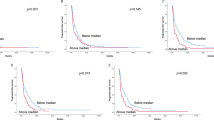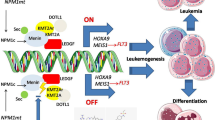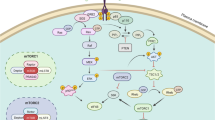Abstract
The phosphoinositide 3-kinase (PI3K)/Akt/mTOR signaling pathway plays an important role in the regulation of signal transduction and broad spectrum of biological processes such as cell metabolism, proliferation, apoptosis, autophagy, senescence, and angiogenesis. Given that activation of (PI3K)/Akt/mTOR signaling is documented for a broad spectrum of human malignancies supporting their growth and progression, the components of this pathway are considered prospective molecular targets for anti-cancer therapies. Here, we report the activation of Akt signaling in A673 Ewing’s sarcoma cell line when compared to non-transformed BJ tert fibroblasts. MK2206, a well-known Akt inhibitor, synergistically increases doxorubicin(Dox)-induced cytotoxicity in A673 cells. In particular, inhibition of Akt signaling in A673 tumor cells potentiated Dox-induced apoptosis and inhibited proliferation of tumor cells. Inhibition of Akt signaling in Dox-treated A673 cells was associated with decreased expression of Rad51 recombinase, thereby suggesting unsuccessful homology-mediated repair of DNA damage induced by topoisomerase II inhibitor. This was consistent with decreased levels of DNA damage repair (DDR) proteins (e.g., phosphorylated forms of ATR, BRCA1, Chk1, and Chk2) in tumor cells treated with combination of MK2206 and Dox. Of note, expression of phosphorylated form of gamma-H2AX in A673 cells treated with Dox in presence of MK2206 was increased, thereby revealing unrepaired DNA damage in Akt-inhibited cells. Collectively, pharmacological inhibition of Akt signaling synergistically increases the efficiency of doxorubicin in Ewing sarcoma A673 cell line and might serve as a prospective molecular target in ES to enhance cytotoxic effects of DNA-topoisomerase II inhibitors.






Similar content being viewed by others
References
Bernstein, M., Kovar, H., Paulussen, M., Randall, R. L., Schuck, A., Teot, L. A., et al. (2006). Ewing’s sarcoma family of tumors: Current management. The Oncologist, 11, 503–519.
Bacci, G., Picci, P., Ferrari, S., Mercuri, M., Brach del Prever, A., Rosito, P., et al. (1998). Neoadjuvant chemotherapy for Ewing’s sarcoma of bone. No benefit observed after adding iphosphamide and etoposide to vincristine, actinomycin, cyclophosphamide, and doxorubicin in the maintenance phase. Results of two sequential studies. Cancer (Phila.), 82, 1174–1183.
Paulussen, M., Ahrens, S., Craft, A. W., Dunst, J., Frohlich, B., Jabar, S., et al. (1998). Ewing’s tumors with primary lung metastases: Survival analysis of 114 (European Intergroup) Cooperative Ewing’s Sarcoma Studies patients. Journal of Clinical Oncology, 16, 3044–3052.
Barker, L. M., Pendergrass, T. W., Sanders, J. E., & Hawkins, D. S. (2005). Survival after recurrence of Ewing’s sarcoma family of tumors. Journal of Clinical Oncology, 23, 4354–4362.
Turc-Carel, C., Aurias, A., Mugneret, F., Lizard, S., Sidaner, I., Volk, C., et al. (1988). Chromosomes in Ewing’s sarcoma. I. An evaluation of 85 cases and remarkable consistency of t(11;22)(q24;q12). Cancer Genetics and Cytogenetics, 32, 229–238.
Sorensen, P. H. B., Lessnick, S. L., Lopez-Terrada, D., Liu, X. F., Triche, T. J., & Denny, C. T. (1994). A second Ewing’s sarcoma translocation, t(21;22), fuses the EWS gene to another ETS-family transcription factor, ERG. Nature Genetics, 6, 146–151.
Delattre, O., Zucman, J., Melot, T., Garau, X. S., Zucker, J. M., Lenoir, G. M., et al. (1994). The Ewing family of tumors - A subgroup of small-round-cell tumors defined by specific chimeric transcripts. New England Journal of Medicine, 331, 294–299.
Bonin, G., Scamps, C., Turc-Carel, C., & Lipinski, M. (1993). Chimeric EWS-FLI1 transcript in a Ewing cell line with a complex t(11;22;14) translocation. Cancer Research, 53, 3655–3657.
May, W. A., Gishizky, M. L., Lessnick, S. L., Lunsford, L. B., Lewis, B. C., Delattre, O., et al. (1993). Ewing sarcoma 11;22 translocation produces a chimeric transcription factor that requires the DNA-binding domain encoded by FLI1 for transformation. Proceedings of the National Academy of Sciences of the United States of America, 90, 5752–5756.
Schleiermacher, G., Peter, M., Oberlin, O., Philip, T., Rubie, H., Mechinaud, F., et al. (2003). Increased risk of systemic relapses associated with bone marrow micrometastasis and circulating tumor cells in localized ewing tumor. Journal of Clinical Oncology, 21, 85–91.
Kinsey, M., Smith, R., & Lessnick, S. L. (2006). NR0B1 is required for the oncogenic phenotype mediated by EWS/FLI in Ewing’s sarcoma. Molecular Cancer Research, 4, 851–859.
Luo, W., Gangwal, K., Sankar, S., Boucher, K. M., Thomas, D., & Lessnick, S. L. (2009). GSTM4 is a microsatellite-containing EWS/FLI target involved in Ewing’s sarcoma oncogenesis and therapeutic resistance. Oncogene, 28, 4126–4132.
Potikyan, G., Savene, R. O., Gaulden, J. M., France, K. A., Zhou, Z., Kleinerman, E. S., et al. (2007). EWS/FLI1 regulates tumor angiogenesis in Ewing’s sarcoma via suppression of thrombospondins. Cancer Research, 67, 6675–6684.
Scotlandi, K., Benini, S., Sarti, M., Serra, M., Lollini, P. L., Maurici, D., et al. (1996). Insulin-like growth factor I receptor-mediated circuit in Ewing’s sarcoma/peripheral neuroectodermal tumor: A possible therapeutic target. Cancer Research, 56, 4570–4574.
Mora, J., Rodríguez, E., de Torres, C., Cardesa, T., Ríos, J., Hernández, T., et al. (2012). Activated growth signaling pathway expression in Ewing sarcoma and clinical outcome. Pediatric Blood & Cancer, 58, 532–538.
Scotlandi, K., Maini, C., Manara, M. C., Benini, S., Serra, M., Cerisano, V., et al. (2002). Effectiveness of insulin-like growth factor I receptor antisense strategy against Ewing’s sarcoma cells. Cancer Gene Therapy, 9, 296–307.
De Alava, E., Panizo, A., Antonescu, C. R., Huvos, A. G., Pardo-Mindán, F. J., Barr, F. G., et al. (2000). Association of EWS-FLI1 type 1 fusion with lower proliferative rate in Ewing’s sarcoma. American Journal of Pathology, 156, 849–855.
Toretsky, J. A., Thakar, M., Eskenazi, A. E., & Frantz, C. N. (1999). Phosphoinositide 3-hydroxide kinase blockade enhances apoptosis in the Ewing’s sarcoma family of tumors. Cancer Research, 59, 5745–5750.
Scotlandi, K., Avnet, S., Benini, S., Manara, M. C., Serra, M., Cerisano, V., et al. (2002). Expression of an IGF-I receptor dominant negative mutant induces apoptosis, inhibits tumorigenesis and enhances chemosensitivity in Ewing’s sarcoma cells. International Journal of Cancer, 101, 11–16.
Toretsky, J. A., Kalebic, T., Blakesley, V., LeRoith, D., & Helman, L. J. (1997). The insulin-like growth factor-I receptor is required for EWS/FLI-1 transformation of fibroblasts. Journal of Biological Chemistry, 272, 30822–30827.
Giorgi, C., Boro, A., Rechfeld, F., Lopez-Garcia, L. A., Gierisch, M. E., Schäfer, B. W., et al. (2015). The insulin-like growth factor-I receptor is required for EWS/FLI-1 transformation of fibroblasts. Oncotarget, 6, 28895–28910.
Kamura, S., Matsumoto, Y., Fukushi, J. I., Fujiwara, T., Iida, K., Okada, Y., et al. (2010). Basic fibroblast growth factor in the bone microenvironment enhances cell motility and invasion of Ewing’s sarcoma family of tumours by activating the FGFR1-PI3K-Rac1 pathway. British Journal of Cancer, 103, 370–381.
Agelopoulos, K., Richter, G. H., Schmidt, E., Dirksen, U., von Heyking, K., Moser, B., et al. (2015). Deep sequencing in conjunction with expression and functional analyses reveals activation of FGFR1 in Ewing sarcoma. Clinical Cancer Research, 21, 4935–4946.
Girnita, L., Girnita, A., Wang, M., Meis-Kindblom, J. M., Kindblom, L. G., & Larsson, O. (2000). A link between basic fibroblast growth factor (bFGF) and EWS/FLI-1 in Ewing’s sarcoma cells. Oncogene, 19, 4298–4301.
Cidre-Aranaz, F., Grunewald, T. G., Surdez, D., Garcia-Garcia, L., Carlos Lazaro, J., Kirchner, T., et al. (2017). EWS-FLI1-mediated suppression of the RAS-antagonist Sprouty 1 (SPRY1) confers aggressiveness to Ewing sarcoma. Oncogene, 36, 766–776.
Zhou, R. R., Jia, S. F., Zhou, Z. C., Wang, Y. F., Bucana, C. D., & Kleinerman, E. S. (2002). Adenovirus-E1A gene therapy enhances the in vivo sensitivity of Ewing’s sarcoma to VP-16. Cancer Gene Therapy, 9, 407–413.
Scotlandi, K., Manara, M. C., Hattinger, C. M., Benini, S., Perdichizzi, S., Pasello, M., et al. (2005). Prognostic and therapeutic relevance of HER2 expression in osteosarcoma and Ewing’s sarcoma. European Journal of Cancer, 41, 1349–1361.
Fleuren, E. D. G., Roeffen, M. H. S., Leenders, W. P., Flucke, U. E., Vlenterie, M., Schreuder, H. W., et al. (2013). Expression and clinical relevance of MET and ALK in Ewing sarcomas. International Journal of Cancer, 133, 427–436.
Uren, A., Merchant, M. S., Sun, C. J., Vitolo, M. I., Sun, Y., Tsokos, M., et al. (2003). Beta-platelet-derived growth factor receptor mediates motility and growth of Ewing’s sarcoma cells. Oncogene, 22, 2334–2342.
Wang, Y. X., Mandal, D., Wang, S., Hughes, D., Pollock, R. E., Lev, D., et al. (2009). Inhibiting platelet-derived growth factor beta reduces Ewing’s sarcoma growth and metastasis in a novel orthotopic human xenograft model. In Vivo, 23, 903–909.
Chou, T. C., & Talalay, P. (1984). Quantitative analysis of dose-effect relationships: The combined effects of multiple drugs or enzyme inhibitors. Advances in Enzyme Regulation, 22, 27–55.
Chang, T. T., & Chou, T. C. (2000). Rational approach to the clinical protocol design for drug combinations: A review. Acta Paediatrica Taiwanica, 41, 294–302.
Chou, T. C. (2008). Preclinical versus clinical drug combination studies. Leukaemia & Lymphoma, 49, 2059–2080.
Yadav, B., Wennerberg, K., Aittokallio, T., & Tang, J. (2015). Searching for drug synergy in complex dose-response landscapes using an interaction potency model. Computational and Structural Biotechnology Journal, 13, 504–513.
Boichuk, S., Bikinieva, F., Nurgatina, I., Dunaev, P., Valeeva, E., Aukhadieva, A., et al. (2020). Inhibition of AKT-signaling sensitizes soft tissue sarcomas (STS) and gastrointestinal stromal tumors (GIST) to doxorubicin via targeting of homology-mediated DNA repair. International Journal of Molecular Sciences, 21, 8842.
Zook, P. (2017). Combination of imatinib mesylate and AKT inhibitor provides synergistic effects in preclinical study of gastrointestinal stromal tumor. Clinical Cancer Research, 23, 171–180.
Stahl, M., Ranft, A., Paulussen, M., Bolling, T., Vieth, V., Bielack, S., et al. (2011). Risk of recurrence and survival after relapse in patients with Ewing sarcoma. Pediatric Blood & Cancer, 57, 549–553.
Lawlor, E. R., & Sorensen, P. H. (2015). Twenty years on: What do we really know about ewing sarcoma and what is the path forward? Critical Reviews in Oncogenesis, 20, 155–171.
Theisen, E. R., Pishas, K. I., Saund, R. S., & Lessnick, S. L. (2016). Therapeutic opportunities in Ewing sarcoma: EWS-FLI inhibition via LSD1 targeting. Oncotarget, 7, 17616–17630.
Zöllner, S. K., Selvanathan, S. P., Graham, G. T., Commins, R. M. T., Hong, S. H., Moseley, E., et al. (2017). Inhibition of the oncogenic fusion protein EWS-FLI1 causes G2-M cell cycle arrest and enhanced vincristine sensitivity in Ewing’s sarcoma. Science Signaling, 10, 8429.
Grohar, P. J., Woldemichael, G. M., Griffin, L. B., Mendoza, A., Chen, Q. R., Yeung, C., et al. (2011). Identification of an inhibitor of the EWS-FLI1 oncogenic transcription factor by high-throughput screening. Journal of the National Cancer Institute, 103, 962–978.
Tawbi, H. A., Burgess, M., Bolejack, V., Van Tine, B. A., Schuetze, S. M., Hu, J., et al. (2017). Pembrolizumab in advanced soft-tissue sarcoma and bone sarcoma (SARC028): A multicentre, two-cohort, single-arm, open-label, phase 2 trial. The Lancet Oncology, 18, 1493–1501.
Gorthi, A., Romero, J. C., Loranc, E., Cao, L., Lawrence, L. A., Goodale, E., et al. (2018). EWS-FLI1 increases transcription to cause R-loops and block BRCA1 repair in Ewing sarcoma. Nature, 555, 387–391.
Gorthi, A., & Bishop, A. J. R. (2018). Ewing sarcoma fusion oncogene: At the crossroads of transcription and DNA damage response. Molecular & Cellular Oncology, 5, 1465014.
Brenner, J. C., Feng, F. Y., Han, S., Patel, S., Goyal, S. V., Bou-Maroun, L. M., et al. (2012). PARP-1 inhibition as a targeted strategy to treat Ewing’s sarcoma. Cancer Research, 72, 1608–1613.
Vormoor, B., & Curtin, N. J. (2014). Poly(ADP-ribose) polymerase inhibitors in Ewing sarcoma. Current Opinion in Oncology, 26, 428–433.
Choy, E., Butrynski, J. E., Harmon, D. C., Morgan, J. A., George, S., Wagner, A. J., et al. (2014). Phase II study of olaparib in patients with refractory Ewing sarcoma following failure of standard chemotherapy. BMC Cancer, 14, 813.
Schafer, E. S., Rau, R. E., Berg, S. L., Liu, X., Minard, C. G., Bishop, A. J. R., et al. (2020). Phase 1/2 trial of talazoparib in combination with temozolomide in children and adolescents with refractory/recurrent solid tumors including Ewing sarcoma: A Children’s Oncology Group Phase 1 Consortium study (ADVL1411). Pediatric Blood & Cancer, 67, 28073.
Chan, S. L., & Mok, T. (2010). PARP inhibition in BRCA-mutated breast and ovarian cancers. Lancet, 376, 211–213.
Venier, R. E., Maurer, L. M., Kessler, E. M., Ranganathan, S., McGough, R. L., Weiss, K. R., et al. (2019). A germline BARD1 mutation in a patient with Ewing Sarcoma: Implications for familial testing and counseling. Pediatric Blood & Cancer, 66, 27824.
Maurer, L., Venier, R., Mukherjee, E., Julian, C., Daley, J., Bailey N., et.al. (2020). PARP inhibition in Ewing sarcoma: impact of germline DNA damage repair defects and activation of immunoregulatory pathways. bioRxiv preprint. https://doi.org/10.1101/2020.09.18.304238.
Brohl, A. S., Patidar, R., Turner, C. E., Wen, X., Song, Y. K., Wei, J. S., et al. (2017). Frequent inactivating germline mutations in DNA repair genes in patients with Ewing sarcoma. Genetics in Medicine, 19, 955–958.
Toulany, M., Lee, K. J., Fattah, K. R., Lin, Y. F., Fehrenbacher, B., Schaller, M., et al. (2012). Akt promotes post-irradiation survival of human tumor cells through initiation, progression, and termination of DNA-pkcs-dependent DNA double-strand break repair. Molecular Cancer Research, 10, 945–957.
Deng, R., Tang, J., Ma, J. G., Chen, S. P., Xia, L. P., Zhou, W. J., et al. (2011). PKB/Akt promotes DSB repair in cancer cells through upregulating Mre11 expression following ionizing radiation. Oncogene, 30, 944–955.
Holler, M., Grottke, A., Mueck, K., Manes, J., Jücker, M., Rodemann, H. P., et al. (2016). Dual targeting of Akt and mTORC1 impairs repair of DNA double-strand breaks and increases radiation sensitivity of human tumor cells. PLoS One, 11, e0154745.
Jia, Y., Song, W., Zhang, F., Yan, J., & Yang, Q. (2013). Akt1 inhibits homologous recombination in Brca1-deficient cells by blocking the Chk1-Rad51 pathway. Oncogene, 32, 1943–1949.
Plo, I., Laulier, C., Gauthier, L., Lebrun, F., Calvo, F., & Lopez, B. S. (2008). AKT1 inhibits homologous recombination by inducing cytoplasmic retention of BRCA1 and RAD51. Cancer Research, 68, 9404–9412.
Plo, I., & Lopez, B. (2009). AKT1 represses gene conversion induced by different genotoxic stresses and induces supernumerary centrosomes and aneuploidy in hamster ovary cells. Oncogene, 28, 2231–2237.
Mueck, K., Rebholz, S., Harati, M. D., Rodemann, H. P., & Toulany, M. (2017). Akt1 stimulates homologous recombination repair of DNA double-strand breaks in a Rad51-dependent manner. International Journal of Molecular Sciences, 18, 2473.
Ahmed, A. A., Abedalthagafi, M., Anwar, A. E., & Bui, M. M. (2015). Akt and Hippo pathways in Ewing’s sarcoma tumors and their prognostic significance. Journal of Cancer, 6, 1005–1010.
Chandhanayingyong, C., Kim, Y., Staples, J. R., Hahn, C., & Lee, F. Y. (2012). MAPK/ERK signaling in osteosarcomas, ewing sarcomas and chondrosarcomas: Therapeutic implications and future directions. Sarcoma, 2012, 404810.
Juergens, C., Weston, C., Lewis, I., Whelan, J., Paulussen, M., Oberlin, O., et al. (2006). Safety assessment of intensive induction with vincristine, ifosfamide, doxorubicin, and etoposide (VIDE) in the treatment of Ewing tumors in the EURO-E.W.I.N.G. 99 clinical trial. Pediatr Blood Cancer., 47, 22–29.
Paulussen, M., Craft, A. W., Lewis, I., Hackshaw, A., Douglas, C., Dunst, J., et al. (2008). European Intergroup Cooperative Ewing’s Sarcoma Study-92. Results of the EICESS-92 Study: two randomized trials of Ewing’s sarcoma treatment-cyclophosphamide compared with ifosfamide in standard-risk patients and assessment of benefit of etoposide added to standard treatment in high-risk patients. Journal of Clinical Oncology, 26, 4385–4393.
Kushner, B. H., Cheung, N. V., Modak, S., Becher, O. J., Basu, E. M., Roberts, S. S., et al. (2017). A phase I/Ib trial targeting the Pi3k/Akt pathway using perifosine: Long-term progression-free survival of patients with resistant neuroblastoma. International Journal of Cancer, 140, 480–484.
Cho, D. C., Hutson, T. E., Samlowski, W., Sportelli, P., Somer, B., Richards, P., et al. (2012). Two phase 2 trials of the novel Akt inhibitor perifosine in patients with advanced renal cell carcinoma after progression on vascular endothelial growth factor-targeted therapy. Cancer, 118, 6055–6062.
Guidetti, A., Carlo-Stella, C., Locatelli, S. L., Malorni, W., Mortarini, R., Viviani, S., et al. (2014). Phase II study of perifosine and sorafenib dual-targeted therapy in patients with relapsed or refractory lymphoproliferative diseases. Clinical Cancer Research, 20, 5641–5651.
Bendell, J. C., Nemunaitis, J., Vukelja, S. J., Hagenstad, C., Campos, L. T., Hermann, R. C., et al. (2011). Randomized placebo-controlled phase II trial of perifosine plus capecitabine as second- or third-line therapy in patients with metastatic colorectal cancer. Journal of Clinical Oncology, 29, 4394–4400.
Becher, O. J., Gilheeney, S. W., Khakoo, Y., Lyden, D. C., Haque, S., De Braganca, K. C., et al. (2017). A phase I study of perifosine with temsirolimus for recurrent pediatric solid tumors. Pediatric Blood & Cancer, 64,. https://doi.org/10.1002/pbc.26409.
Funding
This work is funded by the International Scientific Board for Young Scientists of Kazan State Medical University (KSMU) (Recipient: Aigul Galembikova).
Author information
Authors and Affiliations
Corresponding author
Ethics declarations
Research Involving Humans and Animals and Informed Consent
The research was performed solely on the mammalian cell lines (informed consent and animals statement are not required).
Competing Interests
The authors declare no competing interests.
Additional information
Publisher's Note
Springer Nature remains neutral with regard to jurisdictional claims in published maps and institutional affiliations.
This article belongs to the Topical Collection: Molecular, Precision and Regenerative Medicine - 2021
Rights and permissions
About this article
Cite this article
Galembikova, A., Boichuk, S. Targeting of AKT-Signaling Pathway Potentiates the Anti-cancer Efficacy of Doxorubicin in A673 Ewing Sarcoma Cell Line. BioNanoSci. 11, 1070–1082 (2021). https://doi.org/10.1007/s12668-021-00901-x
Accepted:
Published:
Issue Date:
DOI: https://doi.org/10.1007/s12668-021-00901-x




